Issue 4: Climate change is affecting freshwater in Aotearoa New Zealand
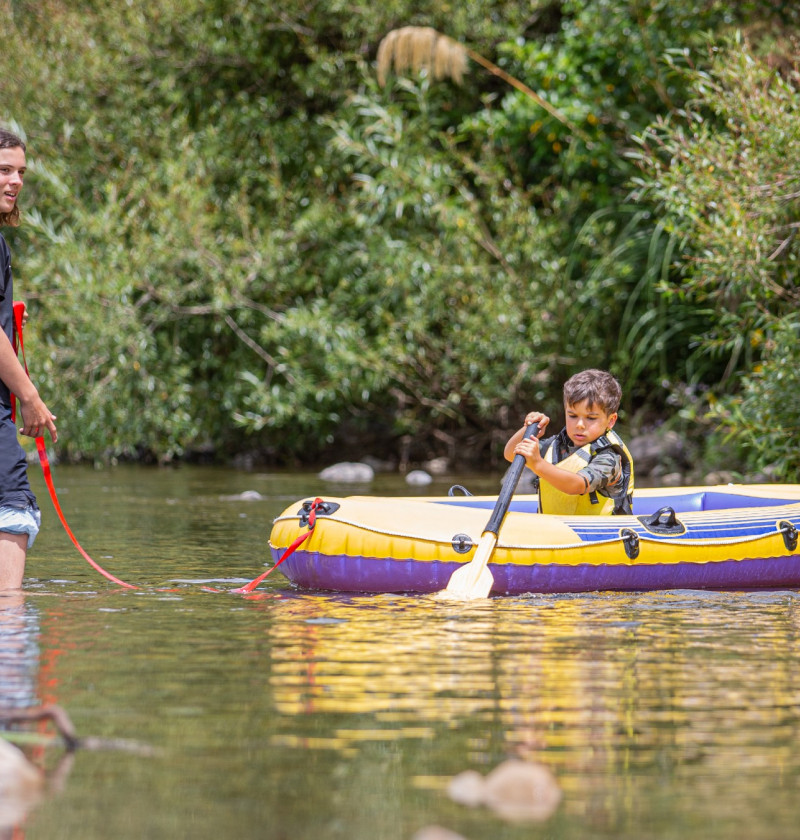

This issue explores how the changes to our climate being caused by greenhouse gas emissions are expected to affect our freshwater.
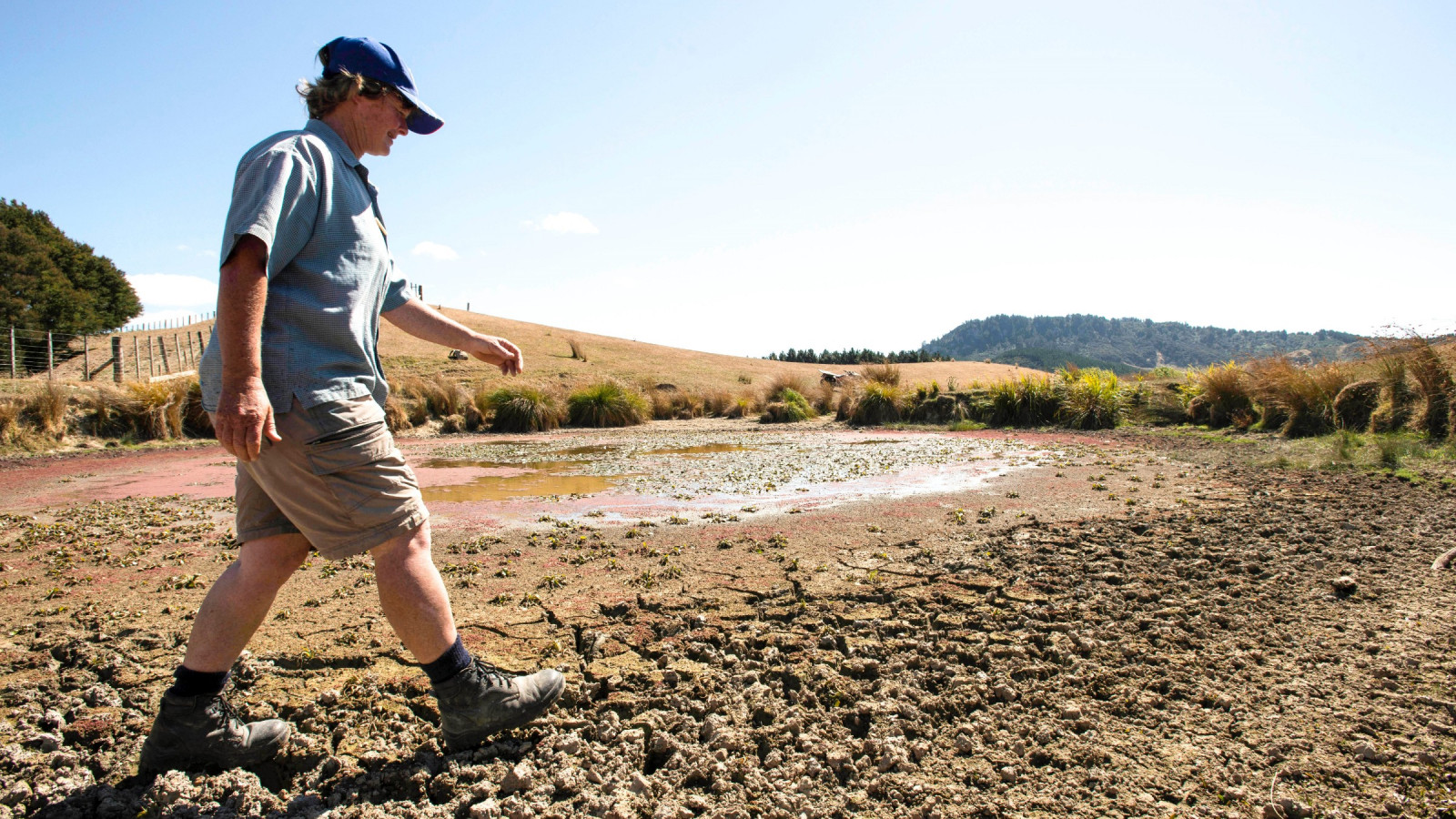
Image: Dave Allen, NIWA
Changes to our climate are already being observed. Climate change is expected to affect when, where, and how much rainfall, snowfall, and drought occur. This may change the amount of water in our soil and in glaciers, lakes, rivers, and groundwater.
The frequency of extreme weather events is expected to increase. The flows, mixing, and temperature of water in lakes, rivers, and groundwater is also projected to change.
Ultimately, all these changes will affect what we do (including where and how we produce food), our economy, and how and where we live. The things we value, including our health, culture, and opportunities for recreation may also be affected.
This issue contains updated information since Environment Aotearoa 2019 including new or updated data from these measures and indicators:
Information about how climate change can affect water mixing in lakes is included. In an infographic, īnanga demonstrate the different ways that climate change may affect a native fish species.
How much our climate warms and changes depends on global emissions, but how emissions will change into the future is unknown.
The effects of climate change are variable across the country. While some – glacier ice extent and sea-level rise – are already obvious, others are less certain.
The other issues highlighted in this report are likely to be intensified by climate change:
Climate change is affecting all parts of New Zealand, with varying impacts on different species, ecosystems, regions, and sectors of the economy.
Some changes are significantly different from pre-industrial conditions (temperature, glacier ice extent, sea level), while others (extreme rainfall) are not yet consistently detectable.
Many impacts are permanent or irreversible on a human timescale. Others are reversible but depend on the level of greenhouse gases in the atmosphere, which may stay high for thousands of years.
Environmental, cultural, and economic systems are already affected. Impacts on other values like health and recreation are expected to increase.
As reported in Environment Aotearoa 2019, many significant changes in New Zealand’s climate have already been observed across the country. Regional variations can also be seen, particularly for rain and snowfall.
For some impacts, such as changes in extreme rainfall events, changes to the baseline have not yet been detected. Other impacts, such as rising sea levels, are already significantly different from pre-industrial conditions.
The effects of climate change will intensify with time.
Many effects are irreversible on a human timescale. Some, like species extinction are permanent. Stopping further emissions will not return us to a normal climate because carbon dioxide remains in the atmosphere for centuries to millennia. As long as greenhouse gas concentrations stay elevated, the risk from extreme events like heat waves, droughts, and storms will be elevated.
There is also a lag of up to several decades between when greenhouse gases are added to the atmosphere and when changes occur. This means that the climate will continue to warm and effects will intensify for many years after global emissions are reduced.
The following points illustrate the wide-ranging changes affecting our freshwater that have already been observed (for details see Our atmosphere and climate 2017).
From 1960 to 2016, most locations did not record changes in rainfall intensity. As at 2016, the proportion of annual rainfall occurring in intense events decreased at four of 30 locations (Auckland, New Plymouth, Rotorua, and Taupō) but increased at Napier and Timaru. (See indicator: Rainfall.) The inability to detect trends in rainfall intensity at most locations may be partly due to the relatively short time for which there is data and because intense events are infrequent.
Studies have identified climate change as a factor in flooding events in Golden Bay in 2011 (Dean et al, 2013) and Northland in 2014 (Rosier et al, 2015), and as contributing to the cost of floods in the last decade (Frame et al, 2018).
New Zealand’s annual average temperature has increased by 1 degree Celsius since 1909. (See indicator: Temperature.)
Since 1972/73, soils at a quarter of the monitoring sites around New Zealand have become drier. (No change was detected at about three-quarters of sites, but where change was detected, it was skewed toward what would be expected in a warming climate – soil moisture decreased at seven sites and increased at one. (See indicator: Drought.)
From 1977 to 2016, glaciers are estimated to have lost almost 25 percent (13.3 cubic kilometres) of their ice. The maximum volume of ice was recorded in 1997 and from then until 2016, 15.5 cubic kilometres of ice was lost, enough to fill Wellington Harbour 12 times. (See indicator: Annual glacier ice volumes.)
New Zealand’s mean relative sea level has risen by 1.81 (±0.05) millimetres per year on average since records began. (See indicator: Coastal sea-level rise.) The rate of sea-level rise has increased in recent decades – the mean rate in the past 58 years (1961–2018) was more than twice the rate in the approximately 60 years before that.
Regional measurements show consistent increases but are largest in Wellington, partly because land is subsiding and seas are rising. Some places, including Nelson, have experienced flooding during the highest high tides even in calm weather (MfE, 2017b).
Computer models can be used to predict future changes in river flows across the country. These models show that flows are likely to increase on the west coast of the South Island and in rivers that drain the eastern side of the Southern Alps. Flows are predicted to decrease on the east coast of the North and South Islands, and in Waikato and Northland but these predictions are less certain (Gluckman et al, 2017; Collins et al, 2018) (see figure 16).
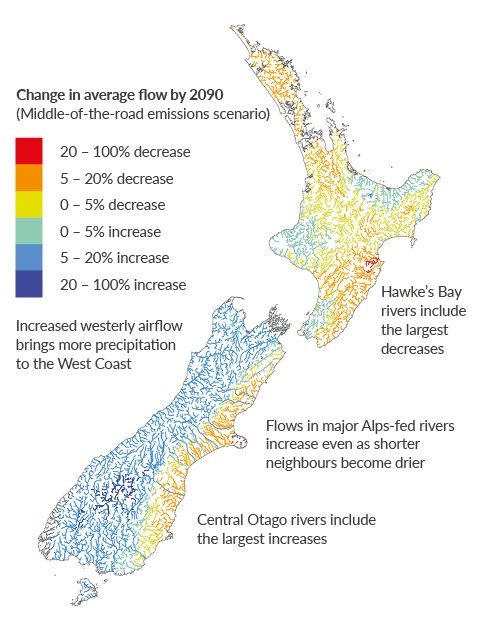
Image: NIWA, 2016. Adapted from Collins, 2013 (Data source)
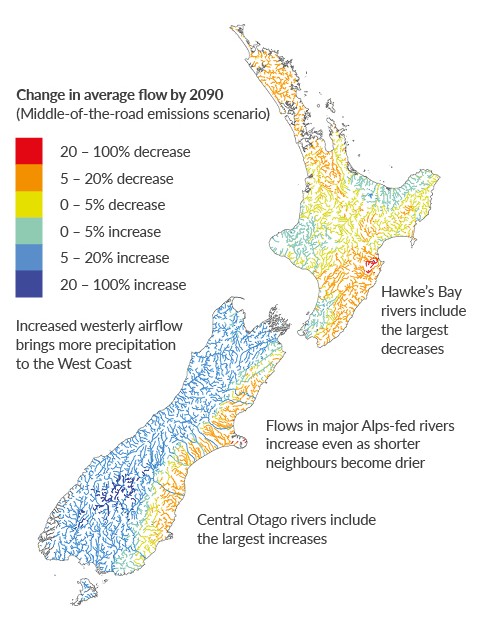
Image: NIWA, 2016. Adapted from Collins, 2013 (Data source)
Note: Based on the A1B emissions scenario from IPCC AR3 and general circulation models.
Snowfall is projected to decrease in the future. Computer models predict a 3–44 percent reduction at 1,000 metres by 2040. The projected decreases in snowfall will alter the flows in rivers and streams that originate in alpine areas. This could affect the large rivers and lakes we use for hydroelectricity and irrigation (Hendrikx et al, 2012).
Droughts will also have an impact on our river flows and groundwater, and affect parts of the country differently (Hendy et al, 2018). Extreme rainfall, drought, and sea-level rise may have cumulative effects that intensify the pressures of our activities on freshwater.
The mixing of water layers is an important process for many lakes. Mixing moves nutrients within lakes, replenishes the oxygen dissolved in deeper water, and affects what types of species can live in a particular lake. The extent of mixing has seasonal patterns in many lakes.
Shallow lakes (less than 10 metres deep) are usually well mixed. Their surfaces are warmed by air, wind, and sunshine, which create currents and move water around. Deeper lakes (greater than 10 metres) are warmer near the surface but colder at the bottom. Denser cold water sinks to the bottom while warm water near the surface continues to be warmed by the sun. These effects combine to prevent mixing and result in layered or stratified water.
Long periods of stratification can cause a build-up of nutrients that may cause harmful algal blooms near the surface and stimulate the breakdown of organic matter in deeper water. These effects deplete the dissolved oxygen in a lake and reduce the water clarity. Lower clarity and less light reduce the amount of native aquatic plants, which provide habitat and replenish dissolved oxygen (Schallenberg et al, 2013; Canfield & Langeland, 1985; Gallegos, 2001). Fish that are trapped in low-oxygen conditions use more energy to breathe, and their behaviour, growth, and reproduction can be adversely affected (Franklin, 2014). Many bottom-dwelling species, including kōura and kākahi, cannot survive in low-oxygen conditions.
New Zealand’s lakes have experienced more intense stratification in recent decades (Verburg et al, 2010). Stratification is expected to become more pronounced as our climate warms, and will have the greatest effect on our many shallow and coastal lakes, with temporary periods of stratification becoming longer and more frequent (Hamilton et al, 2013).
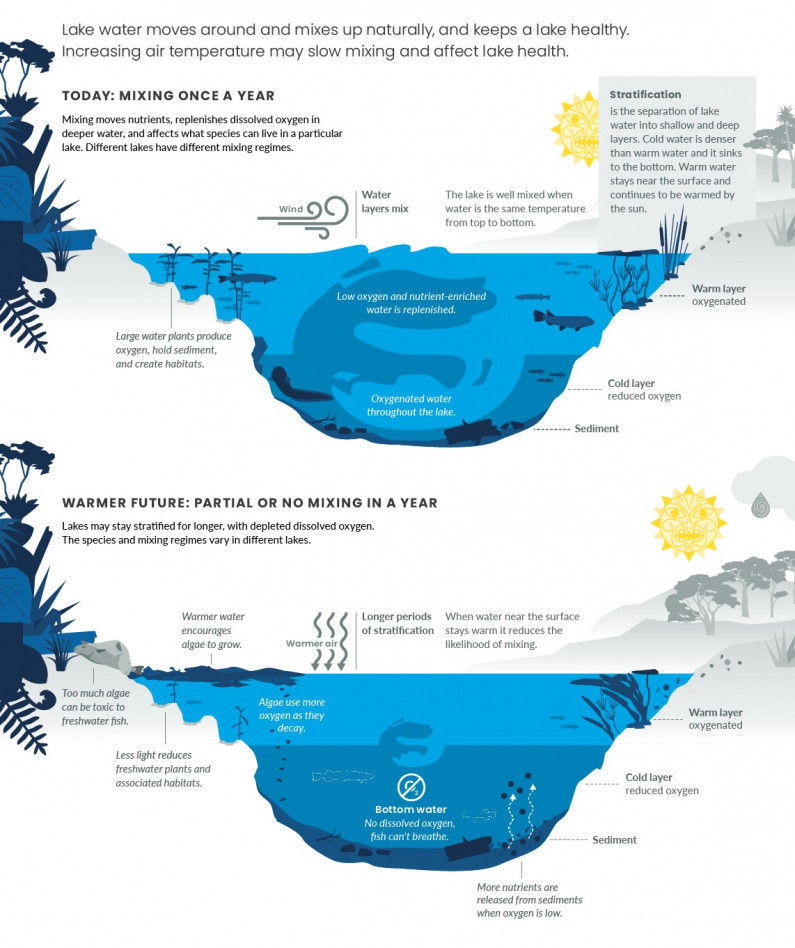
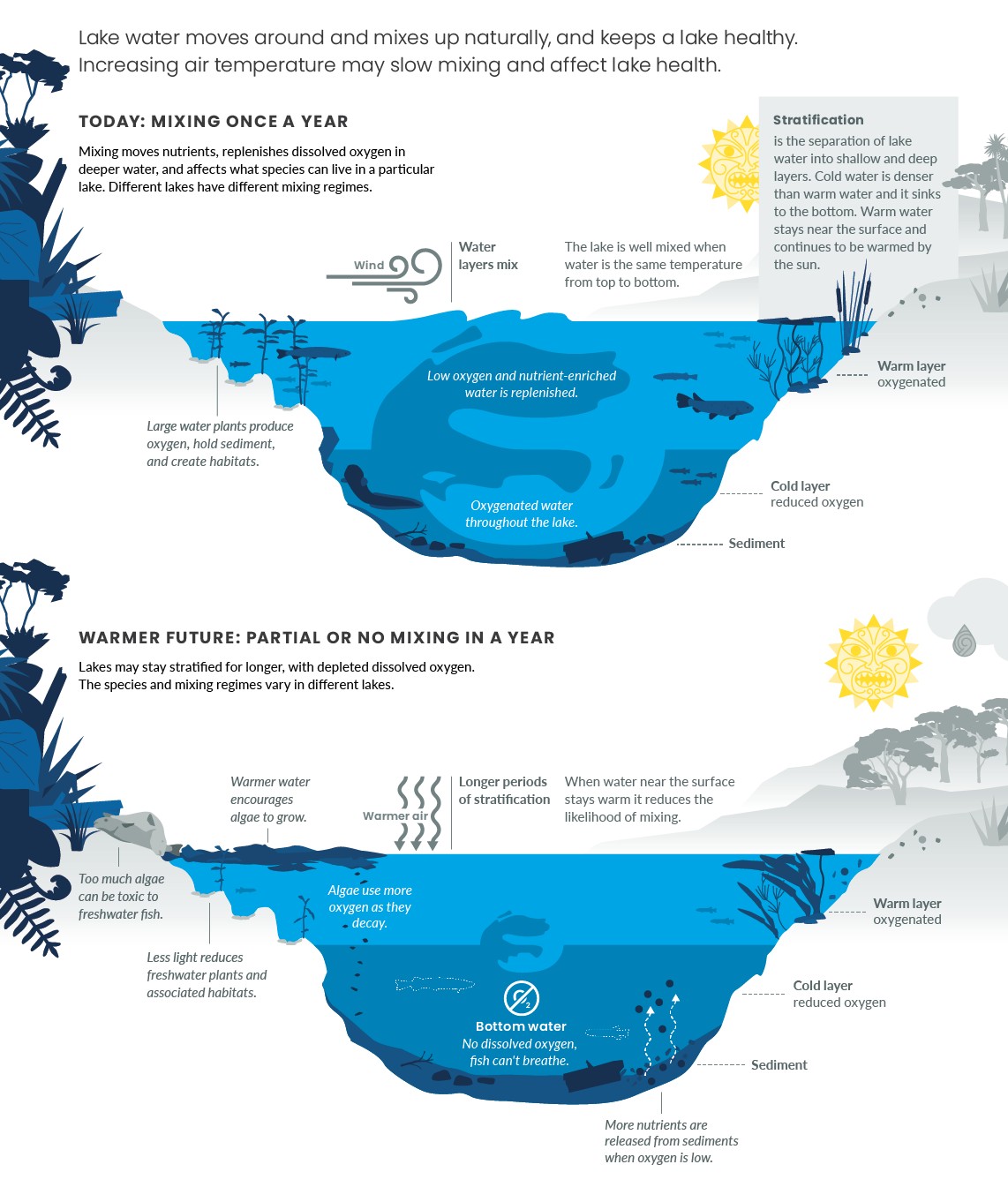
Read the long description for Climate change and lake health
Lake water moves around and mixes up naturally, and keeps a lake healthy. Increasing air temperature may slow mixing and affect lake health. Stratification is the separation of lake water into shallow and deep layers. Cold water (reduced oxygen) is denser than warm water and it sinks to the bottom. Warm water (oxygenated) stays near the surface and continues to be warmed by the sun.
Today, there is mixing once a year. This moves nutrients, replenishes dissolved oxygen in deeper water, and affects what species can live in a particular lake. Different lakes have different mixing regimes.
In a warmer future, there will be partial or no mixing in a year. This means lakes may stay stratified for longer, with depleted dissolved oxygen. The species and mixing regimes vary in different lakes.
The concentration of greenhouse gases in the atmosphere is increasing because of our use of fossil fuels (oil, coal, and gas) for heat, transport, and electricity generation. The rate of emissions is also rising (see Environment Aotearoa 2019). Global emissions have increased dramatically: half of all human-generated carbon dioxide emissions since 1750 have occurred since 1970. From 2000 to 2010, global greenhouse gas emissions increased by about 2.2 percent per year, compared with 1.3 percent per year from 1970 to 2000 (IPCC, 2014). Global carbon dioxide concentrations have risen by about 20 parts per million per decade since 2000. This rise is up to 10 times faster than any sustained rise during the past 800,000 years (Lüthi et al, 2008; Bereiter et al, 2015).
New Zealand’s greenhouse gas emissions contribute a small proportion to the total global emissions, but we have high emissions per capita, mainly because of methane and nitrous oxide emissions from agriculture, our high rate of car ownership, and our aging vehicle fleet.
The sources of our greenhouse emissions and changes over time were reported in Environment Aotearoa 2019 and Our atmosphere and climate 2017. Agricultural industries contribute the most (49.7 percent) to our total emissions. Household emissions increased by 19.3 percent between 2007 and 2017 (Stats NZ, 2019).
Climate change is likely to shift where some native and introduced species are found. Higher water temperatures could cause species to be found further south but be lost from the northern parts of their current ranges. Affected species may include stream invertebrates like kōura, and native fish, trout, and salmon (Ryan & Ryan, 2006). Warmer temperatures could also reduce the number of young eels migrating upstream from the sea (August & Hicks, 2008).
Some native fish that migrate to the sea and back during their life cycle (including those caught as whitebait) are sensitive to several climate-driven changes. Water temperature influences their growth. Drought affects the survival of their eggs and the ability of hatched larvae to move downstream. Floods can wash out and destroy eggs that are laid in the vegetation beside a waterway (Goodman, 2018; Hayes et al, 2019). Floods are also a signal for these fish to migrate, so changes in the height and variability of floods could also affect these species (Goodman, 2018). Sea-level rise could affect the success of īnanga spawning by forcing the fish into upstream areas that do not have appropriate vegetation for egg-laying (Kettles & Bell, 2016).
Climate change is likely to cause major changes in ecological communities and interactions between species. The extent of these changes is unknown (McGlone & Walker, 2011). Climate change could also make ecosystems and organisms more susceptible to other stresses like pollution and fire.
Estuaries, lagoons, and wetlands near the coast are especially sensitive to climate change – they are exposed to changes in freshwater flows downstream as well as rising sea levels (Rodríguez et al, 2017). Coastal erosion and rising seas (which moves salt water into freshwater environments) may cause these ecosystems and their diverse habitats to be reduced or lost. This process will change the make-up of communities if some species are less salt-tolerant (MfE, 2017b). Even small changes in salinity (saltiness) can affect freshwater species and habitats (Schallenberg et al, 2003; Cañedo-Argüelles et al, 2013; Neubauer et al, 2013). Īnanga, for example, only spawn when the salinity is within a specific range (Goodman, 2018).
Climate change will negatively affect Māori cultural and environmental values and practices, including those that relate to freshwater (King & Penny, 2006). Some vulnerable and taonga species may lose parts of their habitats or become extinct (Hennessy et al, 2007).
Local kaitiaki, hapū, and whānau fishers are already noting seasonal shifts that affect their kaitiakitanga practices and harvest times, as well as the indicators that signal them (Deep South National Science Challenge: vision mātauranga, 2018). Iwi, hapū, and whānau are using cultural health indicators to understand the changes and guide their work to restore, protect, and enhance vulnerable taonga species and ecosystems.
Extreme rainfall events are likely to become more common in most areas and could cause increased flooding (Royal Society Te Apārangi, 2016). Flooding can damage housing and transport, energy, stormwater, and wastewater systems. About 675,000 New Zealanders are estimated to live in areas prone to flooding from rainfall and overflowing rivers (Paulik et al, 2019). Also, many marae and urupā (burial sites) are on river flood plains or coastal areas that could be vulnerable.
Longer or more frequent droughts will put extra pressure on water supplies. Communities and infrastructure that depend on rain to supply drinking water may be at risk of running out. The cost of treating water during a drought may also increase (Hendy et al, 2018). Droughts are also likely to cause food shortages (Royal Society Te Apārangi, 2017).
As sea levels rise and weather events like storm swells and extreme waves increase, freshwater environments near the coast will become more salty as sea water enters through ground and surface water. This can contaminate drinking and irrigation water supplies and damage stormwater, wastewater, and water supply networks. A sea-level rise of 0.5–1.2 metres is projected to occur by 2100 (Kopp et al, 2014). If seas were to rise 1.5 metres this would put more than 6,000 kilometres of our drinking, waste, and stormwater pipes at risk from salt water, and cause damage from waves and flooding (Simonson & Hall, 2019).
The health risks from drinking or swimming in water contaminated with pathogens (disease-causing microorganisms) such as E. coli and salmonella may increase if extreme rainfall and floods become more frequent (Britton et al, 2010; Gluckman et al, 2017, Hendy et al, 2018; Bennett et al, 2014; Cann et al, 2013) (see Pollution can have health risks).
Some regions and communities, including northern and remote eastern areas of New Zealand, are particularly vulnerable because their water supply systems are less developed. This can limit the availability of reliable and safe drinking water (King et al, 2010; Henwood et al, 2019).
A more variable climate will make droughts and floods more likely. Low rainfall and soil moisture reduce the growth and yield of crops, while long periods of drought can make plants wilt permanently. The timing of a drought makes a big difference to its effect. In late summer when plants have mostly finished growing for the season, a drought does not have the same devastating effect as a dry time in late winter or early spring, which cuts a plant’s productivity (McGlone et al, 2010). Floods can also affect the growth and yield of crops, along with the distribution networks needed to move goods to market.
In dry years, more irrigation may be needed to make up for the lack of rainfall. Droughts are expected to increase the demand for water from agriculture and cause competition for this resource. The demand is likely to be greatest in regions that are already drought-prone because these regions are expected to experience more frequent and intense droughts (see Issue 3: Changing water flows affect our freshwater).

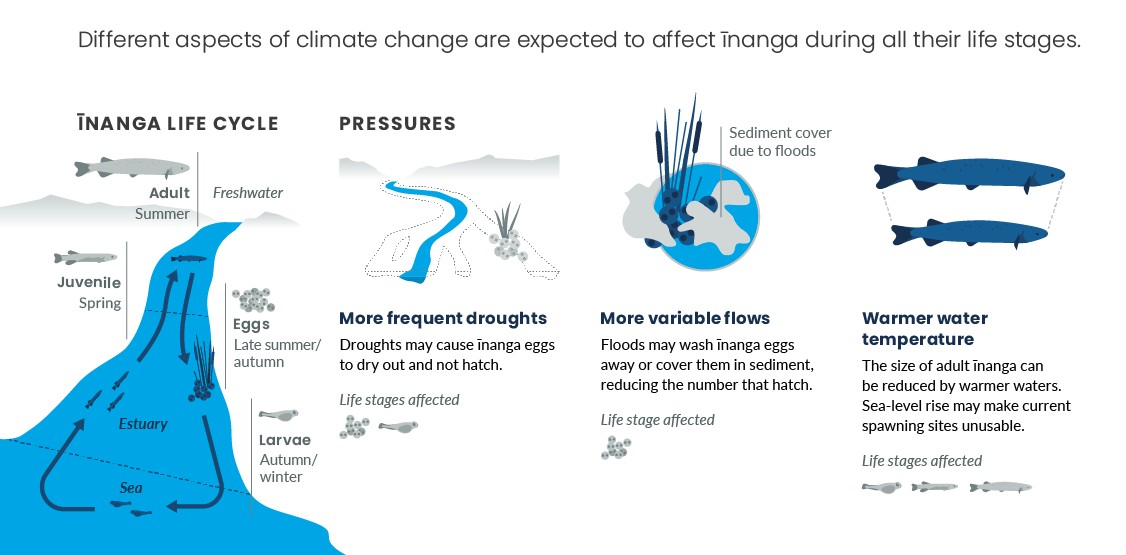
Read the long description for How climate change may affect īnanga
Different aspects of climate change are expected to affect īnanga during all their life stages.
More frequent droughts – droughts may cause īnanga eggs to dry out and not hatch. This affects the egg and larvae stages of the īnanga life cycle.
More variable flows – floods may wash īnanga eggs away or cover them in sediment, reducing the number that hatch. This affects the egg stage of the īnanga life cycle.
Warmer water temperatures – the size of adult īnanga can be reduced by warmer waters. Sea-level rise may make current spawning sites unusable. This affects the larvae, juvenile and adult stages of the īnanga life cycle.
The science underpinning projections of the impacts from a warmed climate is increasing every day, but there are some areas where better knowledge is crucial to understand what we can expect.
The biggest gap in our knowledge is what the total amount of global emissions will be. The amount the climate and oceans warm, and the impacts on New Zealand from these changes, is dependent on the concentrations of greenhouse gases in our atmosphere. The uncertainty of the global emissions trajectory makes quantifying and planning for impacts difficult.
More information about the range of climate change effects on rivers, streams, lakes, and groundwater in catchments, and the interactions between them, is needed. This information would help us understand how and when changes in upstream areas affect downstream freshwater environments. A better understanding of the effects of changing temperatures on freshwater, and how warmer water affects lakes, rivers, and wetland ecosystems, is also needed.
Climate change is causing our oceans to warm and become more acidic. (See indicator: Ocean acidification.) However, there is currently limited information about how changes in the marine environment will affect freshwater fish (including taonga species like eels and īnanga) that spend some of their lives in the ocean. (See Our marine environment 2019.)
These issues have begun to be addressed, but a more thorough understanding of the many effects we can expect will improve our ability to plan for and adapt to the projected changes in our climate.

Issue 4: Climate change is affecting freshwater in Aotearoa New Zealand
April 2020
© Ministry for the Environment